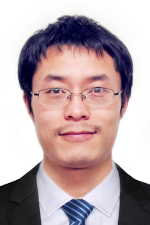About
- Department: State Key Laboratory of Precision Spectroscopy
- Graduate School: University of Colorado
- Degree: Ph.D.
- Academic Credentials: Ph.D.
- PostCode: 200241
- Tel: 021-54836112
- Fax: NA
- Email: hcni@lps.ecnu.edu.cn
- Office: Optics Building A305
- Address: Dongchuan Rd 500, Shanghai
Education
| 2004.09--2008.06 | Nanjing University | B.S. in Physics | | 2008.08--2014.06 | University of Colorado | Ph.D. in Physics |
WorkExperience
| 2014.07--2018.03 | Max-Planck-Institut für Physik komplexer Systeme | Postdoctoral Researcher (Humboldt Fellow) | | 2018.03--2019.09 | Technische Universität Wien | Postdoctoral Researcher (Meitner Fellow) | | 2019.09-- | East China Normal University | Research Professor (NSFC Overseas Excellent Young Scientist) |
Resume
Primarily interested in ultrafast optics, attosecond physics, strong-field physics, AMO physics theories.
We have open positions for undergraduate students, graduate students, and postdoctoral researchers!
Herzlich willkommen bei den Feodor Lynen-Forscher! Ich würde mich freuen, Ihr Wissenschaftlicher Gastgeber zu sein.
Other Appointments
Fellow of Shanghai Association of Young Talents in Science and Technology.
Junior Council Member of Shanghai YinYuan Institute.
Junior Editorial Board Member of Chinese Laser Press, Chinese Optics Letters, and Ultrafast Science.
Journal Reviewing: Physical Review Letters; Physical Review X; Physical Review A; Physical Review B; Physical Review Research; Optics Express; Ultrafast Science; Communications Physics; Scientific Reports; New Journal of Physics; Journal of Physics A; Journal of Physics B; Journal of Physics: Photonics; Journal of Physics Communications; Journal of Optics; Frontiers in Physics; Europhysics Letters (EPL); European Physical Journal D; Science China: PMA; Chinese Physics Letters; Chinese Physics B; Atoms.
Research Fields
There has been an ever-lasting pursuit for ever-faster physical processes and ever-shorter time scales. In the 19th century, the invention of high-speed photography solved the debate over whether there is a moment all four legs of a galloping horse are in the air. In the 1980s, femtosecond (1fs = 10-15s) lasers started to develop, enabling the production of the movie of a chemical reaction. Nowadays, laser sources with even shorter pulse length have matured, whose duration has been down to the attosecond (1as = 10-18s) level, making possible the observation of electronic processes and the formation and breakage of chemical bonds, which are the fastest resolvable physical processes up to date. Strong-field ultrafast optics studies the physical properties of materials under an unprecedented intense field on an unprecedented fine temporal resolution, which is a growing discipline across the globe.

We employ strong short laser pulses, and use theoretical analysis, numerical simulations, as well as AI to study the following topics:
Ultrafast control of ionization time: Observe and control the time of photoionization and tunneling ionization. Photon momentum transfer process: Observe how its photon momentum is transferred to the electron on an ultrafast time scale. Coherent control of chemical processes: Control the formation and breakage of chemical bonds, in order to control the chemical processes and its products. Ultrafast control of solid-state processes: Follow the change of solid HHG and control microscopic processes in solids, such as the buildup of topological states. Ultrafast control of electron correlation: Modulate electron correlation in an ultrafast process.
Do you want to know how to observe and control electron motion on the attosecond time scale? Join the group of Prof. Hongcheng Ni (within a broader team of Prof. Jian Wu) at the State Key Laboratory of Precision Spectroscopy, East China Normal University. Let us chase for the Fast and the Furious! We have open positions for bachelor students, master students, doctoral students, and postdoctoral researchers! Herzlich willkommen bei den Feodor Lynen-Forscher! Ich würde mich freuen, Ihr Wissenschaftlicher Gastgeber zu sein. Research Fields for UndergraduatesWe offer sustained support to undergraduate students for engaging in cutting-edge, long-term research projects. You are welcome to contact us if you are interested. Scientific works undergraduates (underlined) have participated in:
Distinct role of electric field and vector potential in strong-field tunneling ionization
Yongzhe Ma#, Xiaodan Mao#, Lanhe Kong, Qingcao Liu, Hongcheng Ni*, and Jian Wu
Physical Review A 111, 033103 (2025). ▶ PDF PyStructureFactor: A Python code for the molecular structure factor in tunneling ionization rates
Shanshan Song#, Mingyu Zhu# (co-first-author), Hongcheng Ni*, and Jian Wu*
Computer Physics Communications 292, 108882 (2023). ▶ PDF ▶ Code Ionization induced by the ponderomotive force in intense and high-frequency laser fields
Mingyu Zhu, Yuxiang Liu, Chunli Wei, Hongcheng Ni*, and Qi Wei*
Journal of Chemical Physics 158, 164306 (2023). ▶ PDF Influence of nonadiabatic, nondipole and quantum effects on the attoclock signal
Yongzhe Ma, Jinyu Zhou, Peifen Lu, Hongcheng Ni*, and Jian Wu*
Journal of Physics B 54, 144001 (2021). [Invited Article] ▶ PDF
Group Members
| 
| 
| 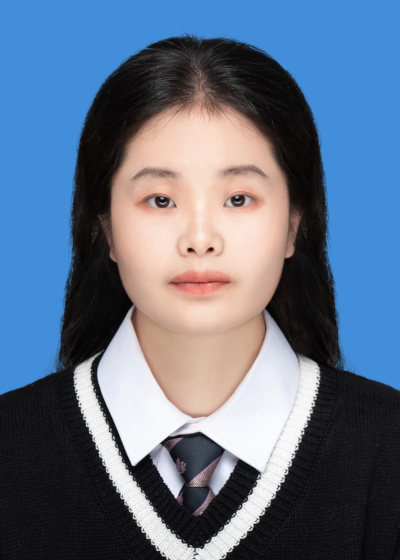
| | Yutong Gao, 2021 | Hao Huang, 2021 | Jingyang Xu, 2024 | Ru Zhang, 2024 |

| 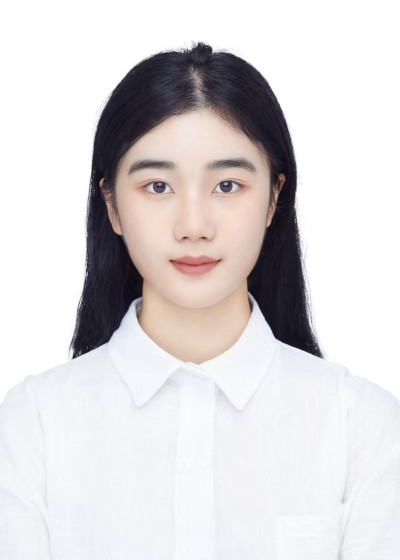
| | Mingyu Zhu, 2025 | Suwen Xiong, 2025 |
Past Members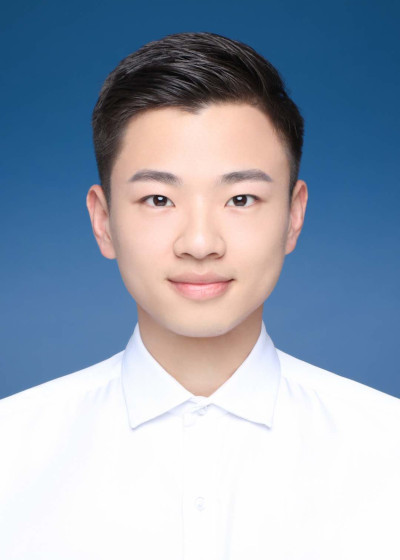
| 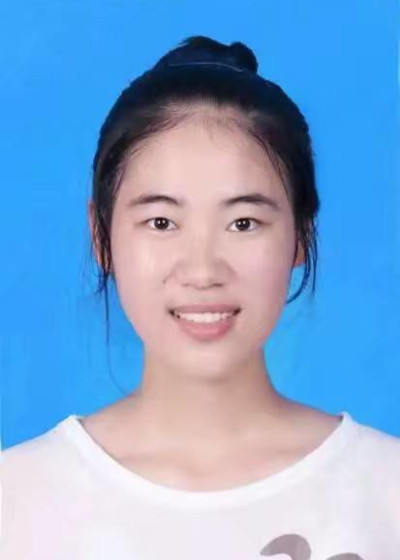
| 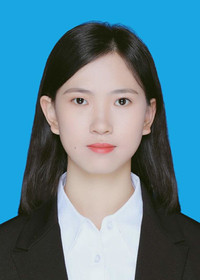
| 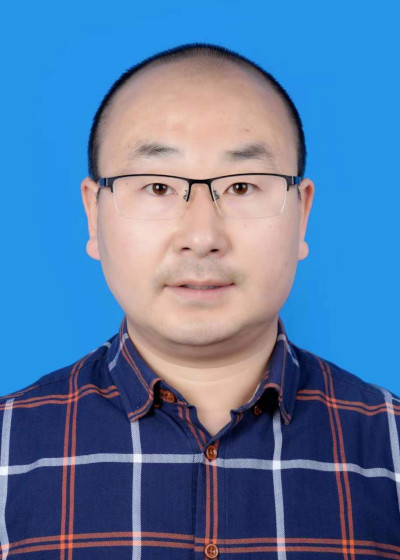
| | Yongzhe Ma, 2019--2024 | Xiaodan Mao, 2020--2025 | Shanshan Song, 2020--2023 | Junping Wang, 2022--2024 | 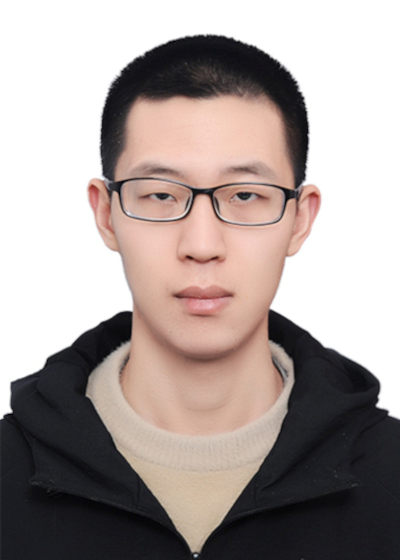
|
|
|
| | Haomai Hou, 2022--2025 |
|
|
|
Course
'Ultrafast Photonics', 5th semester, 36 hours, 2 credits, Hongcheng Ni, Wenbin Zhang, Jian Wu.
Scientific Research
Localization and Delocalization of a Single Molecule in a Helium Nanodroplet  When embedded in superfluid helium nanodroplets, the dopant molecule exhibits either localization or delocalization behaviors that are critically determined by the spatial spread of its wavefuntion, which in turn are influenced by the confining potential of the nanodroplets. Here, we examine the spatial extent of a molecule's wavefunction with respect to the size of the nanodroplet by diagnosing the angular nodal structures in the photoelectron momentum distributions (PMDs). We find that, for the lightest H2 molecules or heavier D2 and O2 molecules, with extents of wavefunction distributions comparable to or smaller than the nanodroplet size, the emitted electrons undergo either minimal or significant scattering with the liquid helium surroundings, leading to either preserved or blurred nodal structures in the PMDs (see Figure). These observations reveal the underlying delocalization or localization of a molecule within the nanodroplet, which is governed by its wavefunctions as determined by the confining potential of the droplet. Our findings provide insight into the quantum solvation dynamics of light impurities in nanoscale and confined systems. Z. Ye, H. Hou, L. Zeng, L. Zhou, Z. Jiang, M. Shi, C. Lu, S. Pan, R. Gong, P. Lu, H. Ni, W. Zhang, F. He, and J. Wu, Phys. Rev. Lett. 135, 213202 (2025). [Editors' Suggestion] [ Featured in Physics] Photon momentum transfer and partitioning: from one to many  The transfer of photon momentum is indispensable in initiating and directing light-matter interactions, which underpins a plethora of fundamental physical processes from laser cooling to laser particle acceleration. The transferred photon momentum is distributed between the photoelectron and the residual ion upon ionization. Our study presents a general and consistent framework for photon momentum transfer covering an arbitrary number of absorbed photons. Our results bridge the gap between the previously considered limiting cases of single-photon and multi-photon strong-field ionization and suggest revising the current consensus for the multi-photon limit by demonstrating that with each additional photon absorbed above the ionization threshold, the photoelectron acquires on average twice the momentum of the absorbed photon (see Figure). Our work paves the pathway towards a comprehensive understanding of the fundamental processes of photon momentum transfer in light-matter interactions, with implications for both theoretical physics and practical applications that harness the transfer of photon momentum. X. Mao, H. Ni, K. Lin, P.-L. He, H. Liang, S. Eckart, F. He, K. Ueda, R. Dörner, and J. Wu, Nat. Commun. 16, 5977 (2025). eTraj.jl: Trajectory-based simulation for strong-field ionization  The dynamics of light-matter interactions in the realm of strong-field ionization has been a focal point and has attracted widespread interest. We present the eTraj.jl program package (see Figure), designed to implement established classical/semiclassical trajectory-based methods to determine the photoelectron momentum distribution resulting from strong-field ionization of both atoms and molecules. The program operates within a unified theoretical framework that separates the trajectory-based computation into two stages: initial-condition preparation and trajectory evolution. For initial-condition preparation, we provide several methods, including the Strong-Field Approximation with Saddle-Point Approximation (SFA-SPA), SFA-SPA with Non-adiabatic Expansion (SFA-SPANE), and the Ammosov-Delone-Krainov theory (ADK), with atomic and molecular variants, as well as the Weak-Field Asymptotic Theory (WFAT) for molecules. For trajectory evolution, available options are Classical Trajectory Monte-Carlo (CTMC), which employs purely classical electron trajectories, and the Quantum Trajectory Monte-Carlo (QTMC) and Semi-Classical Two-Step model (SCTS), which include the quantum phase during trajectory evolution. The program is a versatile, efficient, flexible, and out-of-the-box solution for trajectory-based simulations for strong-field ionization. It is designed with user-friendliness in mind and is expected to serve as a valuable and powerful tool for the community of strong-field physics. Subcycle Conservation Law in Strong-Field Ionization  Exploiting the infinite-order continuous dynamical rotational symmetry of circularly or elliptically polarized classical light pulses (see Figure), we establish the conservation law between the angular momentum and energy in strong-field ionization that is applicable at the subcycle level. We illustrate the conservation law through the correlated spectrum of angular momentum and energy of photoelectrons, both at the tunnel exit and in the asymptotic region. Moreover, we propose a protocol based on electron vortices to directly visualize the existence of the subcycle conservation law. Our work paves the pathway toward a deeper understanding of fundamental light–matter interactions on the subcycle scale. Y. Ma, H. Ni, Y. Li, F. He, and J. Wu, Ultrafast Sci. 4, 0071 (2024). Y. Ma, X. Mao, L. Kong, Q. Liu, H. Ni, and J. Wu, Phys. Rev. A 111, 033103 (2025). X. Mao, K. Liu, H. Ni, and J. Wu, Phys. Rev. A 111, 033113 (2025). Light-driven bimolecular reaction dynamics  The light-driven formation of trihydrogen cation has been attracting considerable attention because of its important role as an initiator of chemical reactions in interstellar clouds. To understand the formation dynamics, most previous studies focused on creating H3+ or D3+ from unimolecular reactions of various organic molecules. Here we observe and characterize the ultrafast formation dynamics of D3+ from a bimolecular reaction (see Figure), using pump–probe experiments that employ ultrashort laser pulses to probe its formation from a D2–D2 dimer. Our molecular dynamics simulations provide an intuitive representation of the reaction dynamics, which agree well with the experimental observation. We also show that the emission direction of D3+ can be controlled using a tailored two-colour femtosecond laser field. The underlying control mechanism is in line with what is known from the light control of electron localization in the bond breaking of single molecules. L. Zhou, H. Ni, Z. Jiang, J. Qiang, W. Jiang, W. Zhang, P. Lu, J. Wen, K. Lin, M. Zhu, R. Dörner, and J. Wu, Nat. Chem. 15, 1229 (2023). Z. Jiang, H. Huang, C. Lu, L. Zhou, S. Pan, J. Qiang, M. Shi, Z. Ye, P. Lu, H. Ni, W. Zhang, and J. Wu, Nat. Commun. 15, 2854 (2024). M. Shi, H. Huang, C. Lu, S. Pan, L. Zhou, Z. Jiang, H. Ni, W. Zhang, and J. Wu, Phys. Rev. X 14, 041001 (2024). H. Huang, H. Hou, J. Wen, H. Ni, and J. Wu, Phys. Rev. A 109, 043107 (2024). Featured in News&Views. PyStructureFactor: A Python code for the molecular structure factor in tunneling ionization rates 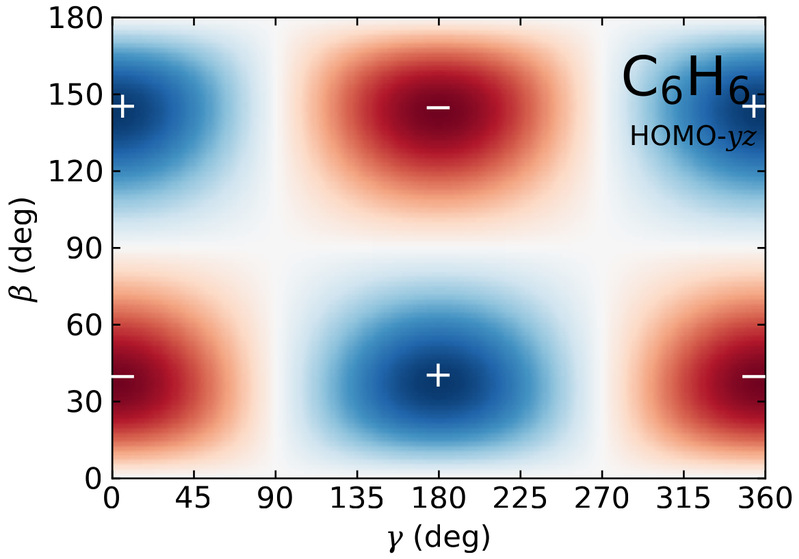 Tunneling ionization is at the core of strong-field and attosecond science. In this work, we present PyStructureFactor — a general Python code towards the calculation of the structure factor in the tunneling ionization rate of common molecules under intense laser fields. The numerical implementation is based on the well-developed weak-field asymptotic theory in the integral representation. The information of the electronic structure of the molecules is obtained via the PySCF quantum chemistry package. PyStructureFactor is a general computational framework that can be utilized to compute the molecular structure factor of various types of molecules, including polar and nonpolar diatomic molecules, degenerate molecules, and open-shell molecules. Examples (see Figure) are given that are benchmarked against known results with good agreements. The present PyStructureFactor is implemented in an efficient manner and is easily applicable towards larger molecules. Rydberg State Excitation in Molecules Manipulated by Bicircular Two-Color Laser Pulses 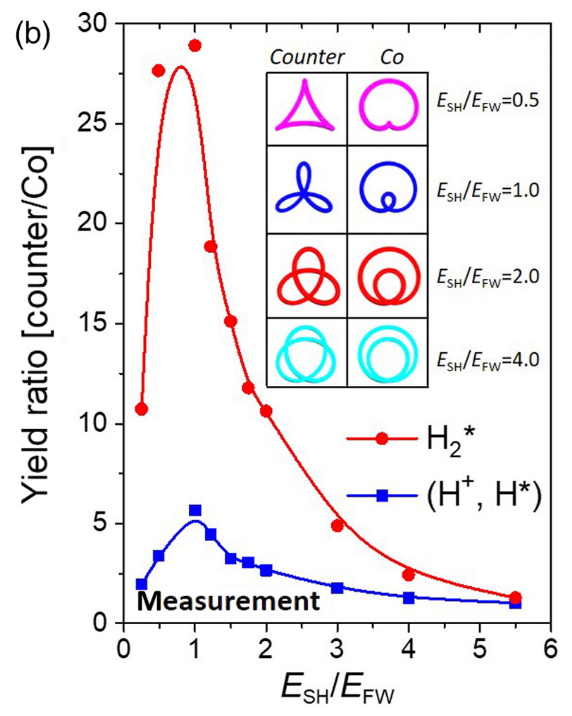 Multiphoton resonant excitation and frustrated tunneling ionization, manifesting the photonic and optical nature of the driving light via direct excitation and electron recapture, respectively, are complementary mechanisms to access Rydberg state excitation (RSE) of atoms and molecules in an intense laser field. However, clear identification and manipulation of their individual contributions in the light-induced RSE process remain experimentally challenging. Here, we bridge this gap by exploring the dissociative and nondissociative RSE of H2 molecules using bicircular two-color laser pulses. Depending on the relative field strength and polarization helicity of the two colors, the RSE probability can be boosted by more than one order of magnitude by exploiting the laser waveform-dependent field effect (see Figure). The role of the photon effect is readily strengthened with increasing relative strength of the second-harmonic field of the two colors regardless of the polarization helicity. As compared to the nondissociative RSE forming H2*, the field effect in producing the dissociative RSE channel of (H+, H*) is moderately suppressed, which is primarily accessed via a three-step sequential process separated by molecular bond stretching. Our work paves the way toward a comprehensive understanding of the interplay of the underlying field and photon effects in the strong-field RSE process, as well as facilitating the generation of Rydberg states optimized with tailored characteristics. W. Zhang, Y. Ma, C. Lu, F. Chen, S. Pan, P. Lu, H. Ni, and J. Wu, Adv. Photon. 5, 016002 (2023). J. Ma, Y. Ma, P. Wang, F. Yang, L. Xiong, Y. Yang, H. Ni, J. Wu, and Z. Sun, Ultrafast Sci. 4, 0053 (2024). Featured in SPIE news and CLP news. Asymmetric attosecond photoionization in molecular shape resonance 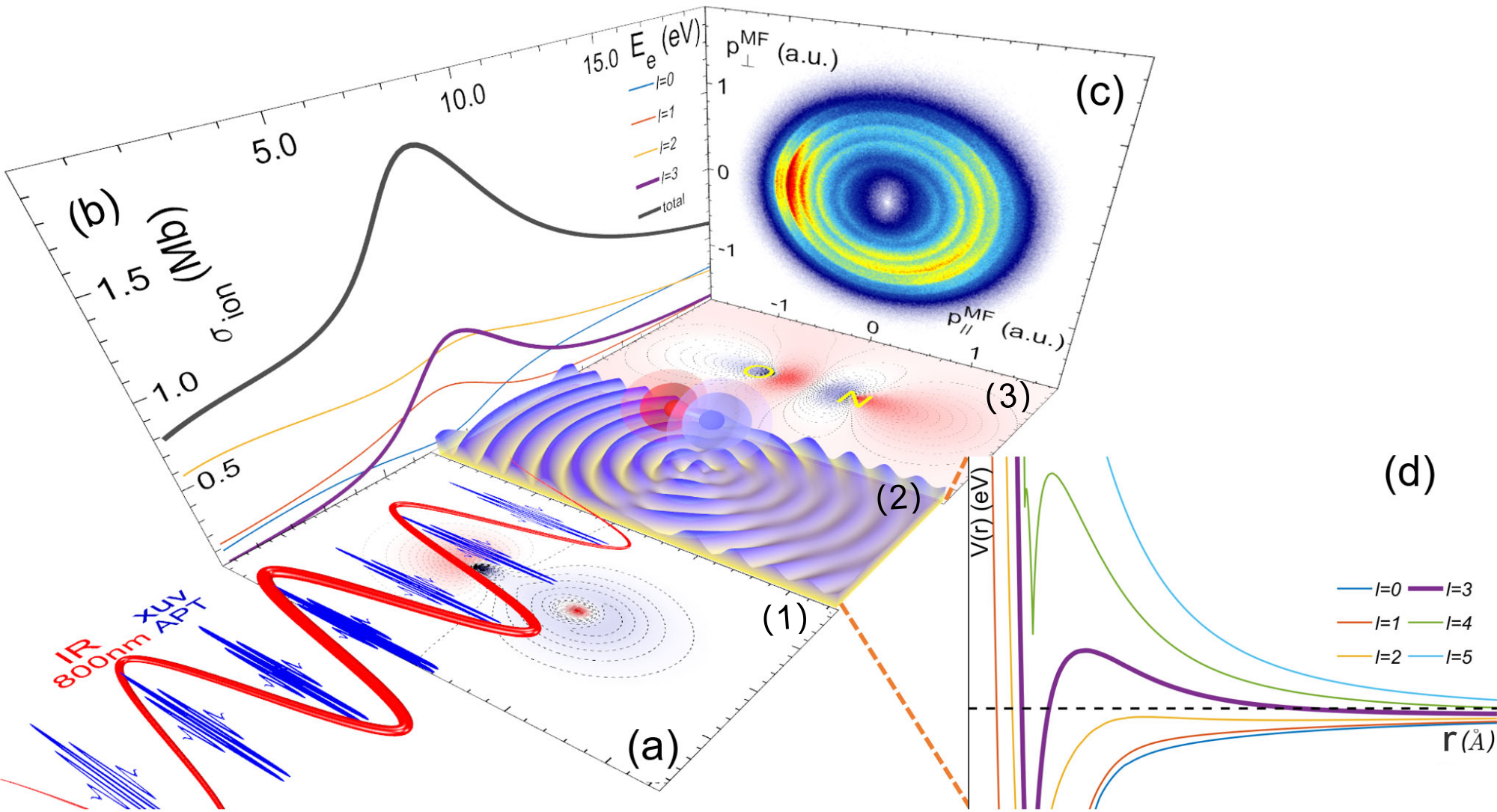 A shape resonance emerges during the light absorption in many molecules with a gigantic burst amplitude and a lifetime of hundreds of attoseconds. Recent advances in attosecond metrology revealed the attosecond lifetime of the shape resonance. For a heteronuclear molecule, the asymmetric initial state and landscape of the molecular potential would lead to an asymmetric shape resonance, whose effect, however, has not been characterized yet. Here we employed an attosecond interferometer to investigate the molecular frame photoionization time delay in the vicinity of the shape resonance of the NO molecule (see Figure). Driven by photons with energy ranging from 23.8 eV to 36.5 eV, a 150 attosecond difference in the time delay was observed between photoemission from the N/O end. Our quantum scattering theoretical simulations reproduce well our experimental findings. It illustrates that the asymmetric time delay originates from the interference between resonant and non-resonant photoionization pathways. X. Gong, W. Jiang, J. Tong, J. Qiang, P. Lu, H. Ni, R. Lucchese, K. Ueda, and J. Wu, Phys. Rev. X 12, 011002 (2022). Transient valence charge localization 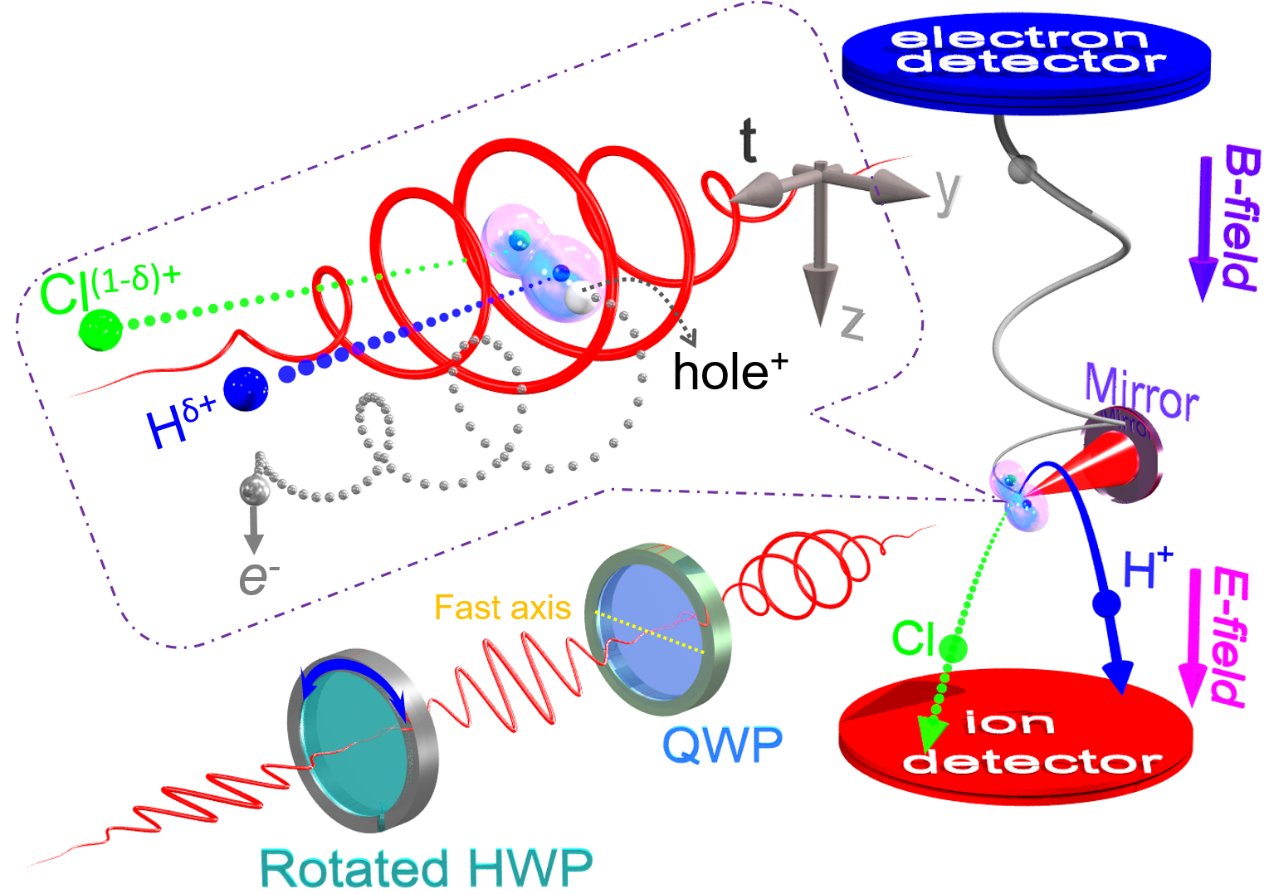 Probing transient charge localization in the inner-shell orbital of atoms and molecules has been made possible by recent progress of advanced light sources. Here, we demonstrate that the ultrafast electron tunneling ionization by an intense femtosecond laser pulse could induce an asymmetric transient charge localization in the valence shell of the HCl molecule during the dissociative ionization process. The transient charge localization is encoded in the recoil momentum acquired by the outgoing ionic fragments, and the asymmetry is revealed by carefully examining the electron tunneling-site distinguished momentum angular distribution of the ejected H+ fragment (see Figure). Our work proposes a way to visualize the transient valence charge motion and will stimulate further investigations of the tunneling-site-sensitive ultrafast dynamics of molecules in strong laser fields. J. Ma, L. Xu, H. Ni, C. Lu, W. Zhang, P. Lu, J. Wen, F. He, O. Faucher, and J. Wu, Phys. Rev. Lett. 127, 183201 (2021). Subcycle linear momentum transfer in tunneling ionization  Interaction of a strong laser pulse with matter transfers not only energy but also linear momentum of the photons. Recent experimental advances have made it possible to detect the small amount of linear momentum delivered to the photoelectrons in strong-field ionization of atoms. We present numerical simulations as well as an analytical description of the subcycle phase (or time) resolved momentum transfer to an atom accessible by an attoclock protocol (see Figure). We show that the light-field-induced momentum transfer is remarkably sensitive to properties of the ultrashort laser pulse such as its carrier-envelope phase and ellipticity. Moreover, we show that the subcycle-resolved linear momentum transfer can provide novel insights into the interplay between nonadiabatic and nondipole effects in strong-field ionization. This work paves the way towards the investigation of the so-far unexplored time-resolved nondipole nonadiabatic tunneling dynamics. H. Ni, S. Brennecke, X. Gao, P.-L. He, S. Donsa, I. Březinová, F. He, J. Wu, M. Lein, X.-M. Tong, and J. Burgdörfer, Phys. Rev. Lett. 125, 073202 (2020). K. Lin, S. Brennecke, H. Ni, X. Chen, A. Hartung, D. Trabert, K. Fehre, J. Rist, X.-M. Tong, J. Burgdörfer, L. Ph. H. Schmidt, M. S. Schöffler, T. Jahnke, M. Kunitski, F. He, M. Lein, S. Eckart, and R. Dörner, Phys. Rev. Lett. 128, 023201 (2022). [Editors' Suggestion] X. Mao, H. Ni, X. Gong, J. Burgdörfer, and J. Wu, Phys. Rev. A 106, 063105 (2022). X. Mao, H. Ni, and J. Wu, Phys. Rev. A 110, 063113 (2024). X. Mao, H. Ni, and J. Wu, J. Phys. Commun. 9, 125001 (2025). Polarization tagging of two-photon double ionization by elliptically polarized XUV pulses 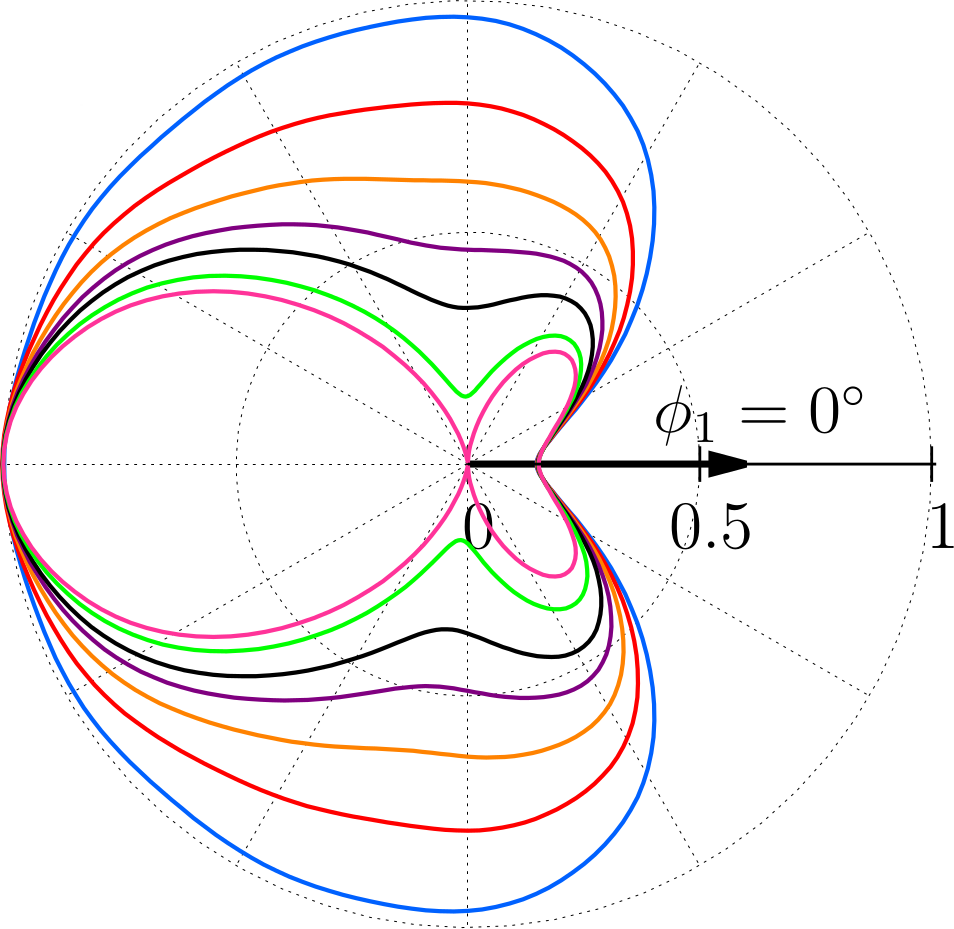 We explore the influence of elliptical polarization on the (non)sequential two-photon double ionization of atomic helium with ultrashort extreme ultraviolet (XUV) light fields using time-dependent full ab initio simulations. The energy and angular distributions of photoelectrons are found to be strongly dependent on the ellipticity. The correlation minimum in the joint angular distribution becomes more prominently visible with increasing ellipticity (see Figure). In a pump-probe sequence of two subsequent XUV pulses with varying ellipticities, polarization tagging allows us to discriminate between sequential and nonsequential photoionization. This clear separation demonstrates the potential of elliptically polarized XUV fields for improved control of electronic emission processes. S. Donsa, I. Březinová, H. Ni, J. Feist, and J. Burgdörfer, Phys. Rev. A 99, 023413 (2019). Deformation of atomic p± orbitals in strong elliptically polarized laser fields: Ionization time drifts and spatial photoelectron separation 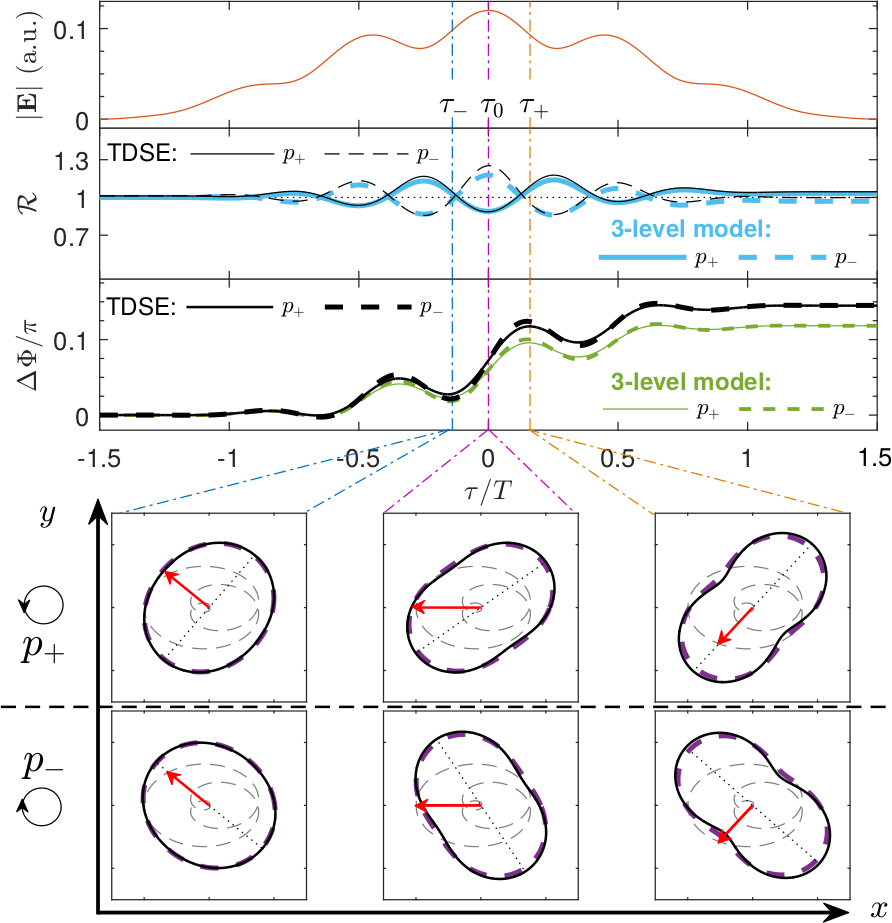 The dynamical orbital shape has so far eluded the studies of strong-field ionization. We theoretically investigate the deformation of atomic p± orbitals driven by strong elliptically polarized (EP) laser fields and the role it plays in tunnel ionization. Our study reveals that different Stark effects induced by orthogonal components of the EP field give rise to subcycle rearrangement of the bound electron density, rendering the initial p+ and p− orbitals deformed and polarized along distinctively tilted angles with respect to the polarization ellipse of the EP field (see Figure). As a consequence, the instantaneous tunneling rates change such that for few-cycle EP laser pulses the bound electron initially counter-rotating (co-rotating) with the electric field is most likely released before (after) the peak of the electric field. We demonstrate that with a sequential-pulse setup one can exploit this effect to spatially separate the photoelectrons detached from p+ and p- orbitals, paving the way towards robust control of spin-resolved photoemission in laser-matter interactions. K. Liu, H. Ni, K. Renziehausen, J.M. Rost, and I. Barth, Phys. Rev. Lett. 121, 203201 (2018). Debate over Tunneling Time Delay Resolved by Backpropagation 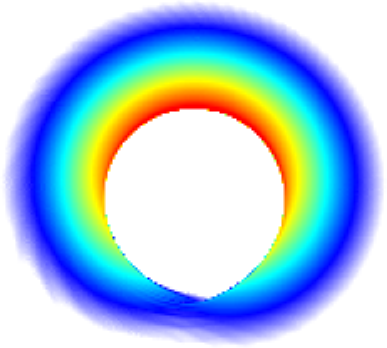 We proposed a backpropagation method to temporally and spatially resolve the tunneling ionization dynamics. The backpropagation method involves a full quantum solution of the tunneling ionization followed by a classical propagation backwards in time in phase space to retrieve initial tunneling exit coordinates, including time and position (see Figure). In contrast to other methods, this method does not employ any assumptions or approximations to the quantum tunneling dynamics, while it is capable to obtain highly differential information regarding to the tunneling process. Thereby, we could also quantify the fraction of electrons that are ionized via tunneling, herewith we able to determine if ionization is in the tunneling regime in the first place. The backpropagation method also enables comparison of different definitions of and approximations to the tunnel exit on the same footing. A direct comparison including or not nonadiabatic tunneling effects reveals, that a positive tunneling time delay results if nonadiabaticity is not considered while a zero delay is obtained if nonadiabatic effects are taken full and consistent account of, thus resolving the long-standing debate over the existence of a finite tunneling delay. H. Ni, U. Saalmann, and J.M. Rost, Phys. Rev. Lett. 117, 023002 (2016). H. Ni, U. Saalmann, and J.M. Rost, Phys. Rev. A 97, 013426 (2018). H. Ni, N. Eicke, C. Ruiz, J. Cai, F. Oppermann, N.I. Shvetsov-Shilovski, and L.W. Pi, Phys. Rev. A 98, 013411 (2018). Y. Ma, J. Zhou, P. Lu, H. Ni, and J. Wu, J. Phys. B 54, 144001 (2021). [Invited Article] C. Hofmann, A. Bray, W. Koch, H. Ni, and N.I. Shvetsov-Shilovski, Eur. Phys. J. D 75, 208 (2021). [Invited Review] Double Photoionization of Helium Dimer  We studied the energy exchange between electrons in a helium dimer upon photon absorption. Results of numerical simulations for double photoionization are found to be in good agreement with recent experimental data for the angular distribution of the emitted electrons. Together with the temporal evolution of the two-electron probability distribution (see Figure) this provides direct evidence for the knockout mechanism. According to this mechanism, the photon energy, which is initially absorbed by an electron at one of the atoms in the dimer, is then shared between the electrons over distances of several Angstroms via an internal collisional process. Using a Hamiltonian reduction method we were also able to study the role of the interactions between different particles in the process. H. Ni, C. Ruiz, R. Dörner, and A. Becker, Phys. Rev. A 88, 013407 (2013). H. Ni and A. Becker, Phys. Rev. A 89, 033402 (2014). H. Huang, H. Ni, J. Wu, Y. Yang, J. Ma, and Z. Sun, Phys. Rev. A 112, 013122 (2025). Featured by Phys. Rev. A in their Kaleidoscope. Delayed Resonant Two-Photon Ionization 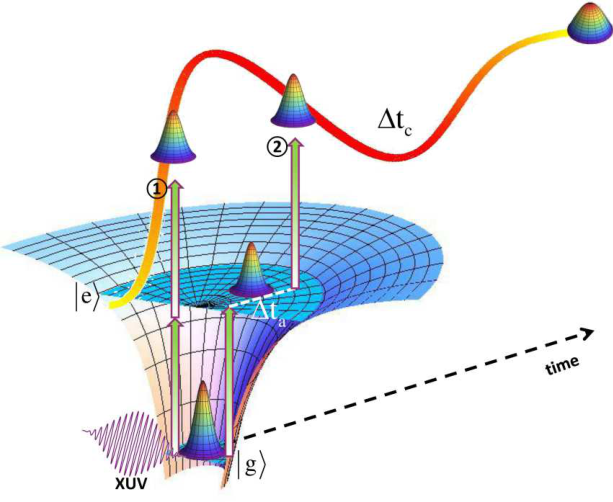 The advancements in the understanding of the attosecond streaking camera technique opens the perspective to retrieve time-resolved information about the dynamics of electrons during transitions inside an atom or molecule. As a prototype example, we showed how the time delay in the resonant two-photon ionization as compared to the instantaneous transition from the ground state to the continuum in a nonresonant process (see Figure) can be retrieved from numerical results for attosecond streaking traces. We found that, the transition delay is linearly proportional to the duration of the ionizing pulse. J. Su, H. Ni, A. Jaroń-Becker, and A. Becker, Phys. Rev. Lett. 113, 263002 (2014). Finite-Range Attosecond Time Delays in Photoionization  Measurements of the photoelectron momentum as a function of the delay between an ionizing XUV and a superimposed infrared streaking pulse have recently revealed temporal offsets for the electron emission from different shells of an atom. We showed that results of related numerical simulations and classical analysis (see Figure) can be interpreted as due to the dynamics of the photoelectron in the Coulomb field of the parent ion and the streaking field. Thus, the time delay is accumulated over a finite range in space, which the photoelectron probes after its transition into the continuum until the streaking pulse ceases. J. Su, H. Ni, A. Becker, and A. Jaroń-Becker, Phys. Rev. A 87, 033420 (2013). J. Su, H. Ni, A. Becker, and A. Jaroń-Becker, J. Mod. Opt. 60, 1484 (2013). J. Su, H. Ni, A. Becker, and A. Jaroń-Becker, Phys. Rev. A 88, 023413 (2013). J. Su, H. Ni, A. Becker, and A. Jaroń-Becker, Chin. J. Phys. 52, 404 (2014). [Invited Review] J. Su, H. Ni, A. Becker, and A. Jaroń-Becker, Phys. Rev. A 89, 013404 (2014). Y. Gao, H. Ni, A. Becker, and J. Wu, Sci. China: Phys. Mech. Astron. 67, 124203 (2024). Selection Rules in Few-Photon Double Ionization 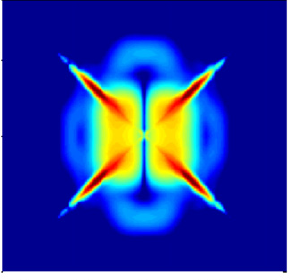 We analyzed the selection rules for the emission of two electrons from the helium atom following the absorption of a few photons from a laser field. The increase of the number of absorbed photons leads to alternating suppression and non-suppression of the back-to-back emission of the two electrons. The Figure shows a snapshot of the two-electron dynamics following single-photon (inner part of distribution) and two-photon double ionization (outer part of distribution). H. Ni, S. Chen, C. Ruiz, and A. Becker, J. Phys. B 44, 175601 (2011). Featured by J. Phys. B in their LabTalk and as the cover article.
Academic Achievements
Representative PublicationsHighlighted Publications Ultrafast Electron–Dipole Interactions in TeO− Photodetachment
Fan Yang, Haomai Hou, Jian Zhang, Xueying Li, Peng Tang, Ye Mei, Junyang Ma, Zhubin Hu, Haitao Sun, Hongcheng Ni*, Xue-Bin Wang*, Jian Wu, Zhenrong Sun*, and Yan Yang*
Journal of Physical Chemistry Letters (accepted, 2025). ▶ PDF Nondipole tunneling dynamics in strong-field ionization from atomic p orbitals
Xiaodan Mao, Hongcheng Ni*, and Jian Wu
Journal of Physics Communications 9, 125001 (2025). [Invited Article] ▶ PDF Localization and Delocalization of a Single Molecule in a Helium Nanodroplet
Zhengjun Ye#, Haomai Hou#, Linqian Zeng, Lianrong Zhou, Zhejun Jiang, Menghang Shi, Chenxu Lu, Shengzhe Pan, Ruolin Gong, Peifen Lu, Hongcheng Ni*, Wenbin Zhang*, Feng He*, and Jian Wu*
Physical Review Letters 135, 213202 (2025). [Editors' Suggestion] [Featured in Physics] ▶ PDF ▶ SuppMat Long-range electron correlation in dissociative double ionization of argon dimers
Hao Huang, Hongcheng Ni*, Jian Wu, Yan Yang, Junyang Ma*, and Zhenrong Sun
Physical Review A 112, 013122 (2025). ▶ PDF Photon Momentum Transfer and Partitioning: From One to Many
Xiaodan Mao, Hongcheng Ni*, Kang Lin*, Pei-Lun He, Hao Liang, Sebastian Eckart, Feng He, Kiyoshi Ueda, Reinhard Dörner, and Jian Wu*
Nature Communications 16, 5977 (2025). ▶ PDF ▶ SuppMat Modification of the saddle-point equation for strong-field ionization from atomic p orbitals
Xiaodan Mao, Kunlong Liu*, Hongcheng Ni*, and Jian Wu
Physical Review A 111, 033113 (2025). ▶ PDF Distinct role of electric field and vector potential in strong-field tunneling ionization
Yongzhe Ma#, Xiaodan Mao#, Lanhe Kong, Qingcao Liu, Hongcheng Ni*, and Jian Wu
Physical Review A 111, 033103 (2025). ▶ PDF eTraj.jl: Trajectory-based simulation for strong-field ionization
Mingyu Zhu, Hongcheng Ni*, and Jian Wu
Computer Physics Communications 311, 109549 (2025). ▶ PDF ▶ Code Visualization of subcycle nonadiabatic-nondipole coupling in strong-field ionization
Xiaodan Mao, Hongcheng Ni*, and Jian Wu
Physical Review A 110, 063113 (2024). ▶ PDF Impact of nuclear motion on light-induced bimolecular interaction dynamics
Menghang Shi#, Hao Huang#, Chenxu Lu#, Shengzhe Pan, Lianrong Zhou, Zhejun Jiang, Hongcheng Ni*, Wenbin Zhang*, and Jian Wu*
Physical Review X 14, 041001 (2024). ▶ PDF Subcycle Conservation Law in Strong-Field Ionization
Yongzhe Ma, Hongcheng Ni*, Yang Li, Feng He, and Jian Wu*
Ultrafast Science 4, 0071 (2024). ▶ PDF ▶ SuppMat Self-consistent extraction of photoabsorption time delays in attosecond streak camera
Yutong Gao, Hongcheng Ni*, Andreas Becker, and Jian Wu
Science China: Physics, Mechanics & Astronomy 67, 124203 (2024). ▶ PDF Ultrafast formation dynamics of D3+ from bimolecular reaction of the D2-D2 dimer
Hao Huang, Haomai Hou, Jin Wen*, Hongcheng Ni*, and Jian Wu*
Physical Review A 109, 043107 (2024). ▶ PDF Ultrafast photoinduced C-H bond formation from two small inorganic molecules
Zhejun Jiang, Hao Huang, Chenxu Lu, Lianrong Zhou, Shengzhe Pan, Junjie Qiang, Menghang Shi, Zhengjun Ye, Peifen Lu, Hongcheng Ni*, Wenbin Zhang*, and Jian Wu*
Nature Communications 15, 2854 (2024). ▶ PDF ▶ SuppMat Two-Dimensional Control of Rydberg Fragment Emission in Dissociative Frustrated Ionization of Oxygen
Junyang Ma#, Yongzhe Ma#, Pengzhao Wang, Fan Yang, Lei Xiong, Yan Yang, Hongcheng Ni*, Jian Wu, and Zhenrong Sun*
Ultrafast Science 4, 0053 (2024). ▶ PDF ▶ SuppMat Advances in Timing and Control of Ultrafast Molecular Dynamics: From XUV to Infrared
Wenyu Jiang, Shengzhe Pan, Hao Huang, Jihong Tong, Wenbin Zhang, Hongcheng Ni*, and Jian Wu
Journal of Physics B 57, 212001 (2024). [Invited Review] ▶ PDF Attosecond Ionization Time Delays in Strong-Field Physics
Yongzhe Ma, Hongcheng Ni*, and Jian Wu*
Chinese Physics B 33, 013201 (2024). [Invited Review] [CPB Highlights of 2024] ▶ PDF Probing and Steering Attosecond Electron Motion Using Tailored Ultrafast Laser Fields
Xiaochun Gong*, Wenbin Zhang, Peifen Lu, Hongcheng Ni, and Jian Wu*
Journal of Physical Chemistry A 128, 401 (2024). [Invited Review] ▶ PDF Attosecond Light Pulse: Time Window Probing Microscopic World (In Chinese)
Mingyu Zhu, Hongcheng Ni*, and Jian Wu
KeXue 76 (1), 56 (2024). [Invited Popular Science] [Reprinted in Xinhua Digest] ▶ PDF Ultrafast formation dynamics of D3+ from the light-driven bimolecular reaction of the D2–D2 dimer
Lianrong Zhou, Hongcheng Ni, Zhejun Jiang, Junjie Qiang, Wenyu Jiang, Wenbin Zhang, Peifen Lu, Jin Wen*, Kang Lin*, Meifang Zhu, Reinhard Dörner, and Jian Wu*
Nature Chemistry 15, 1229 (2023). ▶ PDF PyStructureFactor: A Python code for the molecular structure factor in tunneling ionization rates
Shanshan Song#, Mingyu Zhu#, Hongcheng Ni*, and Jian Wu*
Computer Physics Communications 292, 108882 (2023). ▶ PDF ▶ Code Ionization induced by the ponderomotive force in intense and high-frequency laser fields
Mingyu Zhu, Yuxiang Liu, Chunli Wei, Hongcheng Ni*, and Qi Wei*
Journal of Chemical Physics 158, 164306 (2023). ▶ PDF Rydberg State Excitation in Molecules Manipulated by Bicircular Two-Color Laser Pulses
Wenbin Zhang*, Yongzhe Ma, Chenxu Lu, Fei Chen, Shengzhe Pan, Peifen Lu, Hongcheng Ni*, and Jian Wu*
Advanced Photonics 5, 016002 (2023). ▶ PDF Subcycle-resolved strong-field tunneling ionization: Identification of magnetic dipole and electric quadrupole effects
Xiaodan Mao, Hongcheng Ni*, Xiaochun Gong, Joachim Burgdörfer, and Jian Wu*
Physical Review A 106, 063105 (2022). ▶ PDF Light-Induced Ultrafast Molecular Dynamics: From Photochemistry to Optochemistry
Hui Li, Xiaochun Gong, Hongcheng Ni, Peifen Lu, Xiao Luo, Jin Wen, Youjun Yang, Xuhong Qian, Zhenrong Sun, and Jian Wu*
Journal of Physical Chemistry Letters 13, 5881 (2022). [Invited Review] ▶ PDF Magnetic-Field Effect in High-Order Above-Threshold Ionization
Kang Lin*, Simon Brennecke, Hongcheng Ni, Xiang Chen, Alexander Hartung, Daniel Trabert, Kilian Fehre, Jonas Rist, Xiao-Min Tong, Joachim Burgdörfer, Lothar Ph. H. Schmidt, Markus S. Schöffler, Till Jahnke, Maksim Kunitski, Feng He, Manfred Lein, Sebastian Eckart, and Reinhard Dörner*
Physical Review Letters 128, 023201 (2022). [Editors' Suggestion] ▶ PDF Asymmetric Attosecond Photoionization in Molecular Shape Resonance
Xiaochun Gong, Wenyu Jiang, Jihong Tong, Junjie Qiang, Peifen Lu, Hongcheng Ni*, Robert Lucchese, Kiyoshi Ueda*, and Jian Wu*
Physical Review X 12, 011002 (2022). ▶ PDF Transient Valence Charge Localization in Strong-Field Dissociative Ionization of HCl Molecules
Junyang Ma, Liang Xu, Hongcheng Ni*, Chenxu Lu, Wenbin Zhang, Peifen Lu, Jin Wen, Feng He, Olivier Faucher, and Jian Wu*
Physical Review Letters 127, 183201 (2021). ▶ PDF ▶ SuppMat Influence of nonadiabatic, nondipole and quantum effects on the attoclock signal
Yongzhe Ma, Jinyu Zhou, Peifen Lu, Hongcheng Ni*, and Jian Wu*
Journal of Physics B 54, 144001 (2021). [Invited Article] ▶ PDF Quantum battles in attoscience: tunnelling
Cornelia Hofmann*, Alexander Bray, Werner Koch, Hongcheng Ni, and Nikolay I. Shvetsov-Shilovski
European Physical Journal D 75, 208 (2021). [Invited Review] ▶ PDF Theory of Subcycle Linear Momentum Transfer in Strong-Field Tunneling Ionization
Hongcheng Ni*, Simon Brennecke, Xiang Gao, Pei-Lun He*, Stefan Donsa, Iva Březinová, Feng He, Jian Wu, Manfred Lein, Xiao-Min Tong, and Joachim Burgdörfer*
Physical Review Letters 125, 073202 (2020). ▶ PDF ▶ SuppMat Polarization tagging of two-photon double ionization by elliptically polarized XUV pulses
Stefan Donsa*, Iva Březinová, Hongcheng Ni*, Johannes Feist, and Joachim Burgdörfer
Physical Review A 99, 023413 (2019). ▶ PDF Deformation of atomic p± orbitals in strong elliptically polarized laser fields: Ionization time drifts and spatial photoelectron separation
Kunlong Liu, Hongcheng Ni*, Klaus Renziehausen, Jan-Michael Rost*, and Ingo Barth*
Physical Review Letters 121, 203201 (2018). ▶ PDF ▶ SuppMat Tunneling criteria and a nonadiabatic term for strong-field ionization
Hongcheng Ni, Nicolas Eicke, Camilo Ruiz, Jun Cai, Florian Oppermann, Nikolay I. Shvetsov-Shilovski, and Liang-Wen Pi*
Physical Review A 98, 013411 (2018). ▶ PDF Tunneling exit characteristics from classical backpropagation of an ionized electron wave packet
Hongcheng Ni, Ulf Saalmann, and Jan-Michael Rost
Physical Review A 97, 013426 (2018). ▶ PDF Tunneling ionization time resolved by backpropagation
Hongcheng Ni, Ulf Saalmann, and Jan-Michael Rost
Physical Review Letters 117, 023002 (2016). ▶ PDF Time delays in two-photon ionization
Jing Su, Hongcheng Ni, Agnieszka Jaroń-Becker, and Andreas Becker
Physical Review Letters 113, 263002 (2014). ▶ PDF Theoretical analysis of the role of Coulomb interactions in single and double photoionization of the helium dimer using numerical model simulations
Hongcheng Ni and Andreas Becker
Physical Review A 89, 033402 (2014). ▶ PDF Attosecond streaking time delays: Finite-range property and comparison of classical and quantum approaches
Jing Su*, Hongcheng Ni, Andreas Becker, and Agnieszka Jaroń-Becker
Physical Review A 89, 013404 (2014). ▶ PDF Numerical simulations of attosecond streaking time delays in photoionization
Jing Su, Hongcheng Ni, Andreas Becker, and Agnieszka Jaroń-Becker
Chinese Journal of Physics 52, 404 (2014). [Invited Review] ▶ PDF Finite-range time delays in numerical attosecond streaking experiments
Jing Su, Hongcheng Ni, Andreas Becker, and Agnieszka Jaroń-Becker
Physical Review A 88, 023413 (2013). ▶ PDF Numerical simulations of single-photon double ionization of the helium dimer
Hongcheng Ni, Camilo Ruiz, Reinhard Dörner, and Andreas Becker
Physical Review A 88, 013407 (2013). ▶ PDF Theoretical analysis of time delays and streaking effects in XUV photoionization
Jing Su*, Hongcheng Ni, Andreas Becker, and Agnieszka Jaroń-Becker
Journal of Modern Optics 60, 1484 (2013). ▶ PDF Numerical simulation of time delays in light-induced ionization
Jing Su, Hongcheng Ni, Andreas Becker, and Agnieszka Jaroń-Becker
Physical Review A 87, 033420 (2013). ▶ PDF Selection rules in the few-photon double ionization of the helium atom
Hongcheng Ni*, Shaohao Chen, Camilo Ruiz, and Andreas Becker*
Journal of Physics B 44, 175601 (2011). [Cover Article] ▶ PDF The property of surface waves of water studied by diffraction of light (In Chinese)
Hongcheng Ni, Jinda Lin, Sihui Wang, Jin Zhou, and Huijun Zhou
College Physics 26 (10), 60 (2007). [Editors' Suggestion] ▶ PDF
Honor
| 2025 | 2024 Top Ten Breakthroughs in Basic Research of Optics Nomination Award | | 2024 | 2023 Top Ten Breakthroughs in Basic Research of Optics Nomination Award | | 2021 | NSFC Overseas Excellent Young Scientist | | 2021 | ECNU Excellent Zijiang Youth Scholar | | 2021 | Shanghai Science&Technology 35 Under 35 Award | | 2020 | Shanghai Thousand Talents Scholar | | 2019 | ECNU Zijiang Youth Scholar | | 2019 | IOP Outstanding Reviewer | | 2019 | FWF Meitner Fellow | | 2015 | AvH Humboldt Fellow | | 2013 | University of Colorado Beverly Sears Research Fellowship |
|
